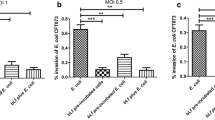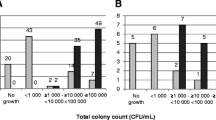Abstract
The effect of buccal epithelial cells (BEC) on bacterial growth was investigated in healthy subjects as well as in patients with recurrent urinary tract infections (UTI) and compared to the antibacterial capacity of uroepithelial cells (UEC) of the same individuals. Epithelial cells were obtained from the following groups: healthy female controls; females without further UTI after reflux operation; females with asymptomatic bacteriuria (ABU); females with further UTI despite successful reflux operation; and patients with meningomyelocele (MMC) and recurrent UTI due to significant residual urinary volume. Cocultivation of Escherichia coli with BEC as well as UEC from healthy females or patients with MMC resulted in significant suppression of bacterial growth. However, neither type of epithelial cell showed an antibacterial effect when they were obtained from patients with recurrent UTI in the absence of urological abnormalities (ABU patients; reflux-corrected patients with further UTI). From these results it is concluded that a generalised epithelial defence defect is one important pathogeneic factor for recurrent idiopathic UTI.
Similar content being viewed by others
Abbreviations
- BEC:
-
buccal epithelial cells
- MMC:
-
meningomyelocele
- UEC:
-
uroepithelial cells
- UTI:
-
urinary tract infection
- VUR:
-
vesico-uretero-renal reflux
- CFU:
-
bacterial colonies
- ABU:
-
asymptomatic bacteriuria
References
Bollgren I, Winberg J (1976) The periurethral aerobic flora in girls highly susceptible to urinary infections. Acta Paediatr Scand 65:81–87
Chick S, Harber M, Mackenzie R, Ascher W (1981) Modified method for studying bacterial adhesion to isolated uroepithelial cells and uromucoid. Infect Immun 34:256–261
Elkins IB, Cox CE (1974) Perineal, vaginal, and urethral bacteriology of young woman. I. Incedence of gram-negative colonization. J Urol 11:88–92
Hagberg L, Jodal U, Korhonen TK, Lidin-Janson G, Lindberg U, Svanborg-Eden C (1981) Adhesion, hemagglutination, and virulence of Escherichia coli causing urinary tract infection. Infect Immun 31:564–570
Hand WL, Smith JU, Sanford JP (1971) The antibacterial effect of normal and infected urinary bladder. J Lab Clin Med 77:605–615
Hofmann K, Marget W, Belohradsky B (1981) Veränderte bakterielle Periurethralflora bei jungen Mädchen mit chronisch rekurrierenden Harnwegsinfektionen? Infection 9:252–254
Iwahi T, Abe Y, Nakao M, Imada A, Tsuchiya K (1983) Role of type 1 fimbriae in the pathogenesis of ascending urinary tract infection induced by Escherichia coli in mice. Infect Immun 39:1307–1315
Johanson WG, Woods DE, Chauduri T (1979) Association of respiratory tract colonization with adherence of gramnegative bacilli to epithelial cells. J Infect Dis 139:667–673
Källenius G, Svenson SB, Hultberg H, Möllby R, Helin I, Cedergren B, Winberg J (1981) Occurence of P-fimbriated Escherichia coli in urinary tract infections. Lancet II:1369–1472
Lachner F, Marget W (1984) Bakterielle Adhäsion an Bukkalepithelien als Dauerindikator für rekurrierende Harnwergsinfektionen. Monatsschr Kinderheilkd 132:666–670
Mannhardt W, Schofer O, Schulte-Wissermann H (1986) Pathogenetic factors in recurrent urinary tract infections in children. Eur J Pediatr 145:330–336
Norden CW, Green CM, Kass ER (1976) Antibacterial mechanisms of the urinary bladder. J Clin Invest 47:2689–2700
Schaeffer AJ, Jones JM, Dum JK (1981) Association of in vitro Escherichia coli adherence to vaginal and buccal epithelial cells of women with susceptibility to recurrent urinary tract infections. N Engl J Med 304:1062–1066
Schaeffer AJ, Jones JM, Duncan JL, Chmiel JS, Plotkin BJ, Falkowsk WS (1982) Adhesion of uropathogenic Escherichia coli to epithelial cells from women with recurrent urinary tract infection. Infection 10:186–191
Schulte-Wissermann H, Mannhardt W, Schwarz J, Zepp F, Bitter-Suermann D (1985) Comparison of the antibacterial effect of uroepithelial cells from healthy donors and children with asymptomatic bacteriuria. Eur J Pediatr 144:230–233
Schulte-Wissermann H, Beetz R, Ludwig KH, Mannhardt W, Schofer O, Tröger J, Riedmiller H, Hohenfellner R (1985) Klinischer Verlauf und Narbenbildung beim operierten vesicorenalen Reflux in einer Langzeitbeobachtung. Klin Wochenschr 63:920–926
Stamey TA, Sexton CC (1975) The role of vaginal colonization with enterobacteriaceae in recurrent urinary infections. J Urol 113:214–217
Stamey TA, Timothy M, Millar M, Mihara G (1971) Recurrent urinary infections in adult women. The role of introital enterobacteria. Calif Med 115:1–19
Winberg J (1978) Urinary tract infections in infants and children. In: Edelmann M (ed) Pediatric kidney disease. Little & Brown, Boston, pp 1123–1144
Author information
Authors and Affiliations
Rights and permissions
About this article
Cite this article
Schofer, O., Ludwig, K.H., Mannhardt, W. et al. Antibacterial capacity of buccal epithelial cells from healthy donors and children with recurrent urinary tract infections. Eur J Pediatr 147, 229–232 (1988). https://doi.org/10.1007/BF00442684
Received:
Accepted:
Issue Date:
DOI: https://doi.org/10.1007/BF00442684




